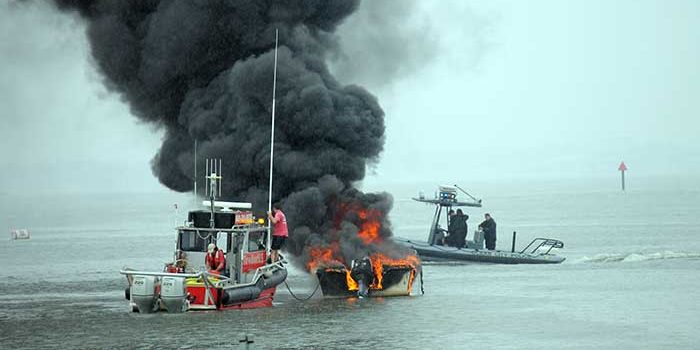We all need to review time-honored recommendations for handling emergencies on the water. This first in a series of posts covers vessel-related emergencies. Later posts will cover medical emergencies, and emergency communications.
Most boating accidents are caused by human error and are preventable (63% human error). Filing a Float Plan before leaving the dock is useful precaution. Using the USPS America’s Boating Club app is a good tool for filing a float plan.
Avoiding Weather Trouble

Be sure to write down your position as rough weather approaches.
If a storm approaches you should write down your position before a storm and monitor your position regularly. Maintain a radio watch during the storm for changes in the weather and for communication with other vessels. If the storm is local, try to run perpendicular to its path, if possible. Refresh your understanding of lightning (see our previous coverage).
Coping With Engine Loss
Losing power can be serious if the seas are rough, or you are near shallow water, in a shipping lane, or in a commercial channel. Even the best-maintained boats might encounter a mechanical problem.
Drop anchor as soon as possible, outside of a channel. To prevent injury or damage in wind or current, use gloves and wrap the hawser around a winch or cleat to allow the anchor to stop the boat gradually, with the proper scope payed out. If the anchor catches on the bottom while the boat is moving in a current, the result can be broken equipment, injuries from snapping lines, and even capsizing.
Anchoring will provide you with time to develop your options. If you are in very deep water, a sea anchor off the bow or a drogue from the stern may be helpful in keeping the bow to the seas and slowing a drift toward shallow water.
Notify the U.S. Coast Guard or other authority of your situation (e.g., engine dead and beginning
repairs).
Loss Of Electric Power
The cause is usually poor batteries, a loose wire, a broken accessories belt, or alternator not functioning. If you cannot make repairs, call for assistance or towing.
Fouled Propeller

Crab pots can bring you to a stop fast. Be sure to have a rigging knife attached to a lanyard when underway.
If you notice an apparent loss of engine power or temperature climbing, you might have a fouled propeller. Stop quickly and anchor to inspect. Always have a marine rigging knife connected to a lanyard available to cut the fouling loose.
Loss Of Steering
Always check your steering linkages before leaving the dock for loose nuts and bolts. Carry spares. Plan for emergency steering aids (see our previous coverage).
Fire Aboard
Most boat fires are either grease fires in the galley or fuel fires in the engine compartment. As soon as a fire is detected, signal a MAYDAY. Get everyone in life jackets and grab your abandon ship kit. Get everyone out of the cabin. Decide whether or not you can fight the fire yourself; otherwise abandon.
On small boats, don’t mount the fire extinguisher at the stern, where most fires break out. Mount it near the helm. Remember PASS: Pull the pin; Aim at the base of the fire; Squeeze the handles together; and Sweep the stream back and forth.
Learn

Students receive a comprehensive, 250-page, PDF Student Guide.
If you want to be better prepared to handle emergencies, take our Boat Handling Course or a component seminar called, Emergencies on Board: Preparing for Handling Common Problems. Another good resource is the USPS Cruising and Cruise Planning course. Lake Hartwell Boating Club offers on-the-water training and certification programs that will allow you to practice the skills taught in this seminar. For more information, submit a contact form referencing Boat Handling.







